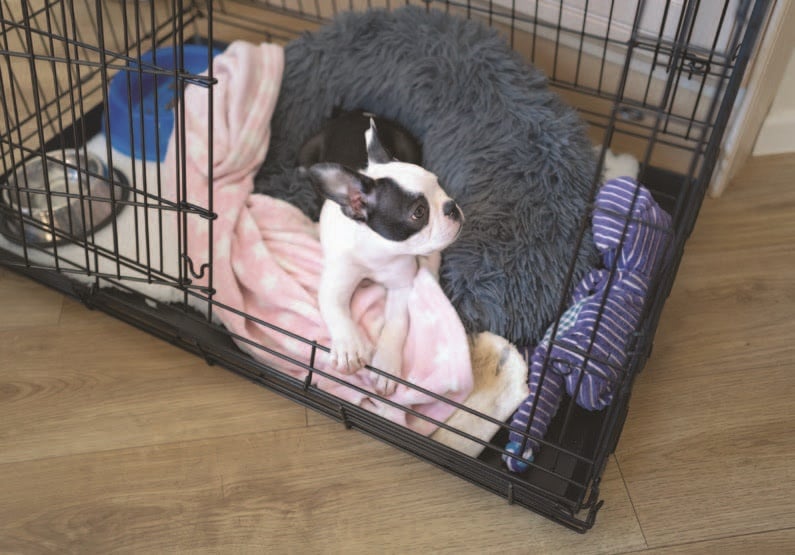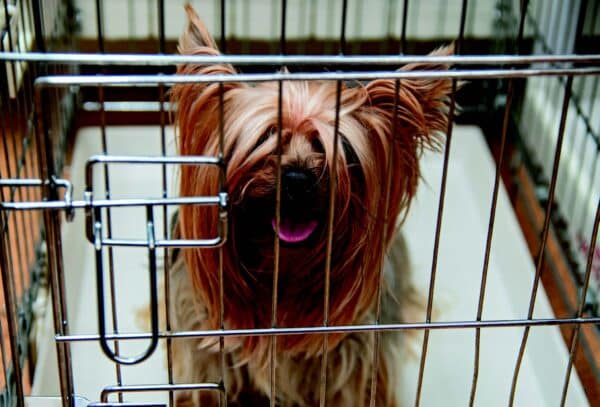Yes, it is generally recommended to crate your dog when you leave the house. Crating your dog can provide a safe and secure environment for them while you are away.
This can prevent destructive behavior, keep them out of harm’s way, and also help with their training and development. However, it’s important to ensure that the crate is a positive space for your dog and not used for extended periods of time.
Gradually introduce your dog to the crate and make it a comfortable space with toys and treats. Always remember to consider your dog’s specific needs and behaviors when deciding whether to crate them when you leave the house.
Benefits Of Crating
Crating your dog when leaving home has numerous benefits, including providing a safe and secure space, reducing anxiety, and preventing destructive behavior. It helps create a routine and establishes boundaries, ensuring the well-being of your furry friend.
Preventing Destructive Behaviors
Ensuring Safety
One question that many dog owners grapple with is whether or not to crate their furry friends when they leave the house. Crating your dog comes with several benefits that can help create a safe and secure environment for your pet. Let’s explore two key advantages of crating: preventing destructive behaviors and ensuring safety.
Preventing Destructive Behaviors
Crating your dog when you leave the house can greatly minimize the risk of destructive behaviors. Dogs, especially puppies, have a natural tendency to explore their surroundings and chew on things. Leaving them unsupervised can lead to damaged furniture, shoes, and household items. By confining your dog to a crate, you provide a controlled environment that limits their access to potential hazards.
Additionally, crating can be an effective tool when you are training your dog. Dogs are den animals by nature, and a crate mimics the cozy and secure environment of a den. When properly introduced to the crate, your dog will view it as their personal safe space, making it easier to establish a routine and set boundaries. Crate training can also aid in housebreaking, as dogs usually avoid eliminating in their sleeping areas.
Ensuring Safety
When you leave your dog alone at home, their safety is of the utmost importance. Dogs are curious creatures and can inadvertently find themselves in dangerous situations. By crating your dog, you can prevent them from accessing potentially harmful areas or objects. This is particularly important if you have a puppy or a dog with a known penchant for getting into mischief.
Moreover, crating your dog can protect them from potential hazards in the house, such as exposed electrical cords, toxic cleaning products, or small objects that can be ingested. It also prevents them from accidentally knocking over furniture or getting trapped in confined spaces. A properly sized and comfortable crate can effectively keep your dog safe when you’re not around.

Credit: www.animalhumanesociety.org
Alternatives To Crating
When it comes to leaving your dog home alone, crating is a common method to ensure their safety and prevent unwanted behaviors. However, for some pet owners, crating may not be the best option. Fortunately, there are several alternatives to crating that can keep your furry friend safe and happy while you’re away.
Using A Dog-proofed Room
Dog-proofing a room in your home can provide a safe and comfortable environment for your dog when you’re not around. Take precautions to remove any potential hazards, such as electrical cords, toxic plants, or small objects that could be chewed. Consider leaving interactive toys or puzzle feeders to keep your pup entertained and mentally stimulated while you’re out.
Hiring A Dog Sitter Or Dog Walker
If leaving your dog alone for extended periods isn’t ideal, consider hiring a dog sitter or dog walker. A professional pet care provider can offer companionship, exercise, and potty breaks for your furry friend while you’re away. This alternative can provide peace of mind knowing that your dog is receiving individual attention and care in your absence.
How To Introduce Crate Training
Introducing crate training to your dog is an important part of establishing good behavior and a sense of security when you’re not at home. When done right, crate training can provide a safe and comfortable space for your dog, preventing destructive behavior and reducing separation anxiety. It’s essential to take the time to introduce the crate properly so that your dog sees it as a positive environment rather than a punishment.
Choosing The Right Crate
When introducing crate training to your dog, it’s crucial to select the right crate that accommodates your dog’s size and provides enough space for them to stand, turn around, and lie down comfortably. Choose a crate that is sturdy and well-ventilated, with secure latches to ensure your dog’s safety.
Creating Positive Associations
To make the crate a welcoming space for your dog, introduce it gradually and associate it with positive experiences. Place comfortable bedding, toys, and treats inside the crate to encourage your dog to explore and spend time inside. Start by leaving the crate door open and allow your dog to enter and exit freely, creating a positive association with the crate.

Credit: www.dogster.com
Crating Dos And Don’ts
Deciding whether to crate your dog when you leave the house can be a tough decision. On one hand, crating can provide a safe and secure space for your dog. On the other hand, some dogs may feel anxious or confined in a crate. To help you make an informed decision, here are some important dos and don’ts to consider.
Don’t Leave Your Dog Crated For Too Long
It’s essential not to leave your dog crated for extended periods of time. While crates can offer a sense of security, spending too much time in a crate can lead to stress, discomfort, and even physical health issues. As a general rule, adult dogs should not be crated for more than 5-6 hours at a time. Puppies, who have smaller bladders and higher energy levels, will need more frequent breaks.
When you crate your dog, it’s important to provide regular exercise and mental stimulation before and after crating. A tired and mentally stimulated dog is more likely to settle down and relax in the crate, reducing the chances of anxiety or restlessness.
| Do: | Don’t: |
|---|---|
|
|
Don’t Use The Crate As A Form Of Punishment
One crucial mistake to avoid when crate training is using the crate as a form of punishment. Your dog should view the crate as a safe and positive space, not as a place of confinement or isolation. Using the crate as punishment can create negative associations and lead to anxiety or resistance to entering the crate.
Instead, focus on positive reinforcement and reward-based training. Make the crate a comfortable and enticing place by using treats, praise, and toys. This will encourage your dog to willingly enter and enjoy spending time in their crate, even when you’re not home.
Possible Concerns And Solutions
When it comes to crate training your dog, there are a few possible concerns that you may have. However, with careful management and the right solutions, these concerns can be addressed effectively.
Separation Anxiety
One of the primary concerns dog owners may have when crating their dogs is the potential for separation anxiety. Dogs are social animals and can feel stressed or anxious when left alone. However, crate training can actually help alleviate separation anxiety if done correctly.
To address separation anxiety, you can follow these solutions:
- Gradually introduce the crate: Let your dog become comfortable by leaving the crate open and allowing them to explore it at their own pace.
- Make the crate a positive space: Create a positive association with the crate by placing treats, toys, and comfortable bedding inside. This will help your dog feel more at ease when they are in the crate.
- Short periods of crate time: Begin by leaving your dog in the crate for short periods of time while you remain in the house. This will help them get used to being in the crate without feeling completely isolated.
- Ignore attention-seeking behavior: If your dog whines or barks for attention while in the crate, it’s important not to give in to their demands. This will only reinforce the behavior and make it more difficult to alleviate separation anxiety in the long run.
Gradual Increase Of Time Spent In Crate
Another concern you may have is the idea of leaving your dog in the crate for extended periods of time. It’s important to gradually increase the duration of crate time to ensure your dog remains comfortable.
Here are some solutions to gradually increase the time spent in the crate:
- Start with short intervals: Begin by leaving your dog in the crate for just a few minutes at a time. Slowly increase the duration as your dog becomes more comfortable and relaxed.
- Create a positive routine: Establish a routine that includes plenty of exercise and mental stimulation before crate time. This will help tire your dog out, making them more likely to relax and sleep while in the crate.
- Use interactive toys: Provide your dog with interactive toys or puzzles that can keep them engaged and entertained while in the crate. This will help alleviate boredom and make crate time more enjoyable for your furry friend.
- Utilize designated potty breaks: Dogs need regular bathroom breaks, so make sure to let them out for potty breaks at appropriate intervals. This will prevent accidents in the crate and make your dog more comfortable during longer crate sessions.
By addressing these concerns and implementing these solutions, you can ensure that crate training is a positive and beneficial experience for both you and your dog.

Credit: www.dogster.com
Frequently Asked Questions Of Should I Crate My Dog When I Leave The House
Should I Crate My Dog When I Leave The House?
Crating your dog when you leave the house can be beneficial for their safety and well-being. It provides a secure and comfortable space for them, reduces the risk of accidents or destructive behavior, and helps with separation anxiety. However, it’s important to ensure the crate is appropriately sized and introduce crate training gradually to make it a positive experience for your dog.
Conclusion
Considering the safety and well-being of your furry friend, crate training can provide numerous benefits. Creating a secure space for your dog when you leave the house can prevent destructive behavior and promote their overall comfort. However, it’s important to introduce the crate gradually and make it a positive experience for your dog.
Remember to consider their individual needs and consult with a professional if needed. So, ultimately, crate training can be a valuable tool in ensuring your pet’s happiness and your peace of mind.



